1969 Topps STAMP PANEL [h]- BOB GIBSON, AL KALINE, CARL YASTRZEMSKI
Paul Schall,Bill Hands,Mike Shannon,Norm Cash,Cleon Jones,Ron Fairly,Reggie Smith,Duke Sims & Steve Whitaker
| Grade |
NEAR MINT to NM/MINT |
| Book Value |
n/a |
| Our Price |
$ 95
Add to cart
|
![1969 Topps STAMP PANEL [h]- BOB GIBSON, AL KALINE, CARL YASTRZEMSKI cards value](/jpgs/6/69s-12.jpg)

Below are short bits & pieces on sportscard & baseball trading card collecting.
Please wander around the website for more info, prices, values & images
on vintage baseball, football, basketball, hockey, sport and non-sports cards.
1959 Fleer Ted Williams baseball cards
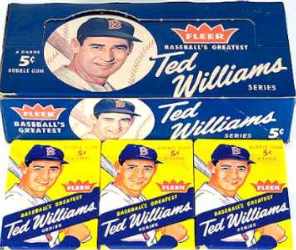
This special 80-card set from the Frank H. Fleer Company honors Ted Williams,
"The Splendid Splinter." While other companies vied for Topps' exclusive player
rights, Fleer successfully secured Ted Williams, who, nearing the end of his
career, remained one of the best and most popular players.
"Teddy Ballgame" had a remarkable career, and the set captures many of his highlights,
including his two Triple Crowns. He is still the last hitter to reach the
.400 mark! Several popular cards feature Ted with other stars, including Babe Ruth,
Jimmie Foxx, football star Jim Thorpe, and golfer Sam Snead.
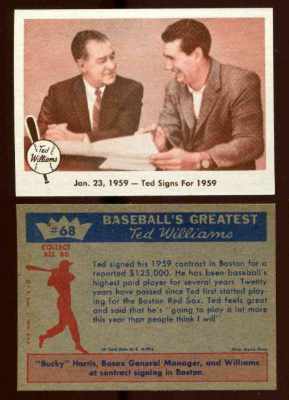 Of particular note is Card #68, "Ted Signs for 1959," which pictures him signing
his contract. The photo also included Red Sox GM Bucky Harris, who was under one
of those exclusive deals with Topps at the time. This led to the card being pulled,
making it extremely scarce. Unfortunately, reprints of the card surfaced in the
1970s. This is widely considered the first baseball card to be
reprinted/counterfeited. Interestingly, the counterfeits were allowed to remain
on the market, so caution is advised when dealing with this card.
Of particular note is Card #68, "Ted Signs for 1959," which pictures him signing
his contract. The photo also included Red Sox GM Bucky Harris, who was under one
of those exclusive deals with Topps at the time. This led to the card being pulled,
making it extremely scarce. Unfortunately, reprints of the card surfaced in the
1970s. This is widely considered the first baseball card to be
reprinted/counterfeited. Interestingly, the counterfeits were allowed to remain
on the market, so caution is advised when dealing with this card.
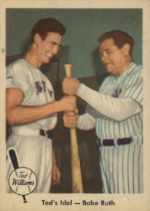 Cards were sold in both six-card and eight-card wax packs. For some reason,
the scarcer 8-card packs contained no gum.
Cards were sold in both six-card and eight-card wax packs. For some reason,
the scarcer 8-card packs contained no gum.
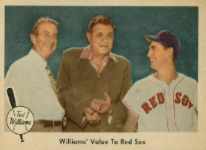
Click for complete
1959 Fleer Ted Williams baseball card set
Note: You may be on that page right now.
Other baseball issues from Fleer:
1960 Fleer Baseball Greats
1961 Fleer Baseball Greats
1963 Fleer Baseball
|

1933 Goudey Baseball Cards
Checklist & Values
1933 Goudey baseball cards were issued during the worst part of
The Great Depression. The set ended up at 240 cards (239 printed
in 1933 and one in 1934). In an effort to attract collectors,
several of the games top players were honored with multiple cards
including "The Great Bambino" who appeared on 4 different cards.
The Babe was once asked why he made more than the President of the
United States, the Babe answered simply: "I had a better year than he did."
The Elusive Nap Lajoie
One of the most important facts regarding the 1933 Goudey set was their
infamous marketing ploy. Goudey took "marketing" to a whole new level
to keep people buying packs by never issuing card #106. Collectors wrote
the Goudey Card Company complaining. They were rewarded with Goudey
sending them the un-issued card #106 (Nap Lajoie) in 1934.
Note: You may be on that page right now.
|

Authentic Major League SIGNED
Game-Used LINEUP Cards (PSA)
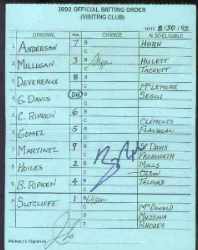
These are the official lineup cards SIGNED BY THE MANAGER & given
to the home plate umpire before the game with the team's line-up
& batting order !!! Making them even neater, often managers made
lineup changes on these cards throughout the game.
These official lineup cards were SIGNED BY THE MANAGER and presented
to the home plate umpire before the game. They detailed the team's lineup and
batting order. Managers often made lineup changes on these cards throughout
the game, making them even more unique.
Collectors say "They are official documents of a particular game, so they are
absolutely historically relevant. The manager, he was the general in the war.
Imagine owning Eisenhower's list of who he wanted to go into battle, and then he
signed it !!! Imagine what that would be worth?"
The first dugout lineup cards were seen around 1960. Along with lineup
cards, most ended up in the trash after games, making them quite rare today.
MLB saw the light and started marketing them directly in the 2000's.
Astronomical prices have been paid for cards from special games.
$165,010 for the Red Sox dugout lineup card from Game 4 of the 2004 World Series.
$138,000 in 2007 for 1st ever All-Star Game batting order cards.
$ 40,000 for batting order cards and the pen used to fill them out from
Cal Ripken's 2,130th & 2,131st games.
Click for complete
Major League SIGNED Game-Used LINEUP cards
Note: You may be on that page right now.
|

Baseball card collecting terms (part B)
Bazooka Bazooka Bubble Gum put baseball cards on the back of their
boxes from 1959 thru 1971. Complete boxes and panels can get extremely costly.
Most kids back then could not afford complete boxes of bubble gum at one
making Bazooka cards quite scarce. I actually don't recall ever obtaining
a Bazooka card directly from a box as a kid. Do you ???
Black Sox Scandal Name given to the the most famous scandal in
baseball history after the 1919 Chicago White Sox versus the Cincinatti Reds
World Series when 8 White Sox players were accused of throwing the series.
Details have remained somewhat unclear. The players were acquitted of
criminal charges but 8 players still received a lifetime ban from
professional baseball including the All-Time great "Shoeless" Joe Jackson.
Blank-Back a card in which nothing is printed on the back.
These cards are usually not in packs and are either "PROOF ISSUES" or
were removed from the factory in some way.
Blanket a term used for collectibles in the 1910's made of fabric .
Border is the part of the card that surrounds the photo or image.
Bowman was a card manufacturer in the 1940's and 1950's that was
bought out by Topps. In 1989 Topps started issuing cards using the Bowman
brand.
Break a term used to indicate the opening of a set, pack, box or case.
Break Value is the total book value of each card added up individually.
The break value of a set is usually way, way more than the value of the complete set.
![1969 Topps STAMP PANEL [h]- BOB GIBSON, AL KALINE, CARL YASTRZEMSKI cards value](/jpgs/6/69s-12.jpg)




 This special 80-card set from the Frank H. Fleer Company honors Ted Williams,
"The Splendid Splinter." While other companies vied for Topps' exclusive player
rights, Fleer successfully secured Ted Williams, who, nearing the end of his
career, remained one of the best and most popular players.
This special 80-card set from the Frank H. Fleer Company honors Ted Williams,
"The Splendid Splinter." While other companies vied for Topps' exclusive player
rights, Fleer successfully secured Ted Williams, who, nearing the end of his
career, remained one of the best and most popular players.
 Of particular note is Card #68, "Ted Signs for 1959," which pictures him signing
his contract. The photo also included Red Sox GM Bucky Harris, who was under one
of those exclusive deals with Topps at the time. This led to the card being pulled,
making it extremely scarce. Unfortunately, reprints of the card surfaced in the
1970s. This is widely considered the first baseball card to be
reprinted/counterfeited. Interestingly, the counterfeits were allowed to remain
on the market, so caution is advised when dealing with this card.
Of particular note is Card #68, "Ted Signs for 1959," which pictures him signing
his contract. The photo also included Red Sox GM Bucky Harris, who was under one
of those exclusive deals with Topps at the time. This led to the card being pulled,
making it extremely scarce. Unfortunately, reprints of the card surfaced in the
1970s. This is widely considered the first baseball card to be
reprinted/counterfeited. Interestingly, the counterfeits were allowed to remain
on the market, so caution is advised when dealing with this card.
 Cards were sold in both six-card and eight-card wax packs. For some reason,
the scarcer 8-card packs contained no gum.
Cards were sold in both six-card and eight-card wax packs. For some reason,
the scarcer 8-card packs contained no gum.

 These are the official lineup cards SIGNED BY THE MANAGER & given
to the home plate umpire before the game with the team's line-up
& batting order !!! Making them even neater, often managers made
lineup changes on these cards throughout the game.
These official lineup cards were SIGNED BY THE MANAGER and presented
to the home plate umpire before the game. They detailed the team's lineup and
batting order. Managers often made lineup changes on these cards throughout
the game, making them even more unique.
These are the official lineup cards SIGNED BY THE MANAGER & given
to the home plate umpire before the game with the team's line-up
& batting order !!! Making them even neater, often managers made
lineup changes on these cards throughout the game.
These official lineup cards were SIGNED BY THE MANAGER and presented
to the home plate umpire before the game. They detailed the team's lineup and
batting order. Managers often made lineup changes on these cards throughout
the game, making them even more unique.
